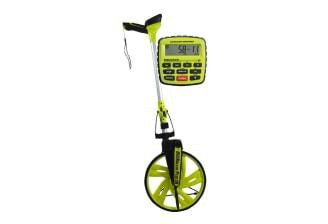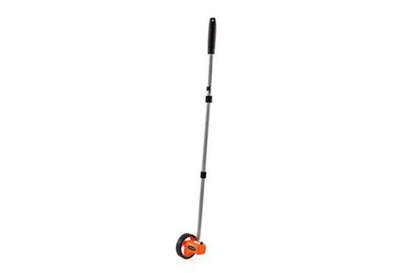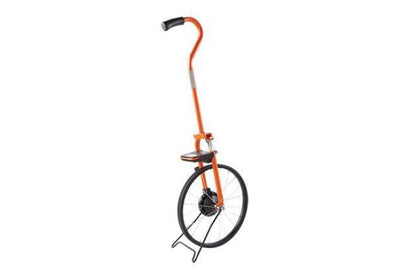There are plenty of options when it comes to distance measuring equipment and tools. We have the familiar measuring tapes, surveyors’ ropes, yard sticks, and state-of-the-art ones that make use of laser and GPS technologies. There are also tools that originated from several centuries ago, yet are still widely used and considered to be reliable today, such as distance measuring wheels.
Distance measuring wheels are known for their usability in measuring long distances. In this article, we will tackle what these wheels are, what their beginning looked like, and what their modern versions boast of today. If you are looking to buy a new distance measuring wheel, this article will also guide you into some of the best measuring wheel features that users find to be highly useful and commendable.
To begin, let’s first talk about the basics.
- I. Distance Measuring Wheel: The Basics
- II. General Types
- III. Best Features of Modern Measuring Wheels
- a. Collapsible Body
- b. Magnified Display
- c. Top-mounted Control Buttons
- d. Counter Encasement
- e. Unit Conversions
- f. Ergonomic Grip Handle
- g. Flip-down Kickstand
- h. Safety Reflector
- i. Automatic Shut Off
- IV. How to Buy a Distance Measuring Wheel
I. Distance Measuring Wheel: The Basics
A measuring wheel has plenty of names. Some people call it the trundle wheel, surveyor’s wheel, and a few others, like a hodometer and perambulator, that can cause confusion to people who aren’t knowledgeable of how this instrument was invented. Today, however, most people just call it a distance measuring wheel and a surveyor’s wheel because of its common use in the land surveying industry.
Distance measuring wheels are estimators, which means that they aren’t ideal for accurate or precise measurements. Rather, they are good for getting approximates of a wide piece of land or even an indoor space.
a. Origin & History
The very first distance measuring wheels date back to the 17th century. Their design is linked to the mechanical design of odometers, except that odometers were initially made for ships while measuring wheels have to be manually rolled on a flat surface with the use of a handle.
Traditional measuring wheels look very similar to the modern ones that are available today. The only differences are some innovative components that improve the convenience and safety of the instruments. The materials used have also changed. While older designs were made with wood, modern designs are mostly constructed with metal, aluminum, and stainless steel.
In 1827, scientist and inventor Francis Ronalds improved the design of measuring wheels by inventing a device that recorded distances graphically. This device features several components, including a worm drive, a slider, a pencil, and a drawing board on which the distance travelled can be recorded. Today, modern measuring wheels have built-in counters or digital displays that quickly reveal the estimated measurement of the distance covered.
b. Original & Current Purpose
Measuring wheels were traditionally used to estimate the distances between territories, such as cities and towns. As for the present time, these tools are usually used to measure properties, like private lands, buildings, and government-owned premises, and to mark their boundaries. They may even be used by homeowners if they would like to survey their land or a portion of it.
Distance measuring wheels are staple tools for some professionals, especially for land surveyors, realtors, engineers, architects, remodelers, and construction workers.
c. How They Work
The basic parts of a distance measuring wheel consist of a wheel and a handle attached to it. This tool is fairly simple to use because of its simple design. A person simply has to place the instrument on the designated starting point, ensure that the counter is at zero, hold the handle, then begin walking with the rolling tool until the designated end point is reached.
One full turn or revolution of a measuring wheel represents the circumference of that wheel. Thus, the distance covered is equal to the wheel circumference multiplied by how many times the wheel turned. Thankfully, users wouldn’t have to calculate this manually as measuring wheel counters do it automatically.
To roll a wheel over a given distance, users can push or pull the device while they walk. Measuring wheels can also be used to measure perimeters. To do that, a user must simply change the position of the tool as needed, without resetting the counter.
However, despite this simplicity, users must remember and pay attention to certain things. First is the fact that measuring wheels are estimators. Thus, if a specific job needs highly accurate measurements, it would be better to use a tool that guarantees better accuracy.
Secondly, these instruments are designed for flat and smooth surfaces. If the wheel is rolled over a bumpy, elevated, or even a muddy surface, the resulting estimate becomes less reliable. The same thing happens when the user keeps changing their pace while walking. Ideally, a user should maintain an even pace throughout the rolling and estimating process.
Third, distance measuring wheels come in different sizes. The general rule is that larger wheels are for outdoor terrains while smaller wheels are good for indoor spaces. It’s also important to know that different measuring wheel models use varying units of measurement. Thus, users can choose a particular model that can work with a unit they are comfortable with or something that suits their specific needs.
Keeping these things in mind can lessen the risks of having an estimate that seems too far off the exact measurement of the covered distance. This is especially important when measuring or marking boundaries, as mistakes could have serious legal implications.
II. General Types
There are two general types of distance measuring wheels: the mechanical type and electronic type. Each type has its share of pros and cons--factors that professionals and companies must consider before deciding to buy distance measuring wheels.
a. Mechanical
Mechanical measuring wheels feature a simple operation. They have a complete set of components that can function without having to be connected to a power source. Thus, they can be very reliable for frequent use in very long distances.
The downside of mechanical types, however, is that they usually offer only a single unit of measurement. Because of that, users don’t have as much flexibility as they could have when they use an electronic type.
b. Electronic

Electronic or digital measuring wheels usually have multiple measurement units. A Keson MP401E Digital Measure Wheel, for example, can measure in feet and inches, continuous inches, feet and tenths, as well as in metric. Electronic types are great for various types of settings, and they’re usually preferred by many professionals because of this.
The only disadvantage of using electronic measuring wheels is their reliance on batteries. However, as long as the batteries are fully charged before use and that users bring spare ones along them, then this shouldn’t cause any problems during an estimating job.
III. Best Features of Modern Measuring Wheels
As mentioned previously, the design of measuring wheels hasn’t changed much since its first appearance in the 17th century. However, what did change are the features that make these instruments more convenient and safer to use.
With that, below is a list of some of the best features that many professionals look for when buying distance measuring wheels. Most of these apply to both mechanical and electronic types, but there a few that apply only to electronic models.
a. Collapsible Body

A collapsible or telescoping body makes an instrument easier to carry and store. Distance measuring wheels are lengthy types of instruments, so having this portable feature is definitely a plus for many buyers.
For professionals who work in several different sites, this feature makes it easy for them to keep their measuring wheel in their vehicle and bring it out only when it is needed.
b. Magnified Display

Older models of measuring wheels often left users squinting and struggling when they have to read the final estimate that their device generated. Because of this, a magnified or larger display is one of the improvements that manufacturers decided to make. This feature lessens the risks of eye strain, which is almost always a part of any measuring job.
c. Top-mounted Control Buttons

Some measuring wheels have their control buttons at the top while others have them at the lower portion of their handle. There are several problems with low-mounted control buttons, especially because users are left with no choice but to stoop or bend just so they can operate the control buttons. Because of that, top-mounted controls make a great feature for many users of measuring wheels.
What’s more, most modern measuring wheels also have enlarged buttons, especially reset buttons. This feature is particularly beneficial for workers who use gloves. With enlarged buttons, they can keep their gloves on and press buttons without any problem.
d. Counter Encasement

Not all measuring wheel counters have an encasement. However, for those that do, the encasement safeguards the counter from different elements that could potentially damage it, such as moisture, rain, and dust.
An example of a measuring wheel with a sealed counter encasement is the Keson 15 1/2" Digital Measure Wheel. Its encasement is compliant with the National Electrical Manufacturers Association (NEMA) Class II standards, which means that it is highly protective against harmful elements.
e. Unit Conversions
Aside from measuring distances in terms of length, some measuring wheels can also convert units and make calculations, such as for volume, area, and circle calculations. An example of a device than can do this is the Digiroller Plus III by Calculated Industries.
f. Ergonomic Grip Handle

Hand and wrist strain are a common problem among professionals who use a distance measuring wheel. It is for this reason that some manufacturers designed their wheels with an ergonomic grip handle. With this type of handle, holding and moving the device becomes less uncomfortable and also easier to control.
g. Flip-down Kickstand

When surveying a piece of land, especially a very spacious one, it is highly likely that professionals will need to pause, either to rest or do another task that needs immediate attention. For situations like this, a measuring wheel with a flip-down kickstand comes in very handy.
This kickstand allows users to pause without compromising the stability of their device. Users may even leave their device for a few moments and come back to it once they can. Also, a flip-down kickstand allows users to store their measuring wheel in a standing or vertical position. This way of storage is often more space-saving than the usual horizontal position, and it also helps in protecting the device from dents and scratches.
h. Safety Reflector

Walking around an open space has some risks associated with it, especially if there are heavy machines and large moving equipment in the area. Because of that, some measuring wheels are designed to provide high visibility with the use of safety reflectors.
Some popular examples of these are the Calculated Industries measuring wheels. Their color is a combination of black and bright green, which is easy to see even against complex backgrounds.
i. Automatic Shut Off
This feature is present in most modern electronic measuring wheels. An automatic shut off is intended to reduce the waste of battery life and, consequently, prolong the usability of batteries.
IV. How to Buy a Distance Measuring Wheel
Having learned about the types and best features of measuring wheels, you now have a guide to refer to when buying this kind of device. To make it simpler, you can start by narrowing down your choices. You can first make a choice between a mechanical and electronic type, between an indoor and outdoor type, and choose a range of wheel circumference that suits your needs.
Your choice of brand is also very important. Here on Engineer Warehouse, we have several top brands that you can check out and choose from, including Keson and Calculated Industries. These companies have decades’ worth of reputation in the industry, and each product of theirs will surely prove to be a wise and cost-effective investment.
Another thing that is important to consider is the product warranty. In the event that you find a faulty component in your measuring wheel, it should be easy for you to have it repaired or replaced. Also, the warranty must be of reasonable coverage. Most warranties are good for one to two years, so be sure to check that before proceeding to checkout.
All products distributed by Engineer Warehouse are covered by manufacturer warranties. If you’re ready to purchase a distance measuring wheel, you can start here where you’re confident that only the best brands and best products are featured.












